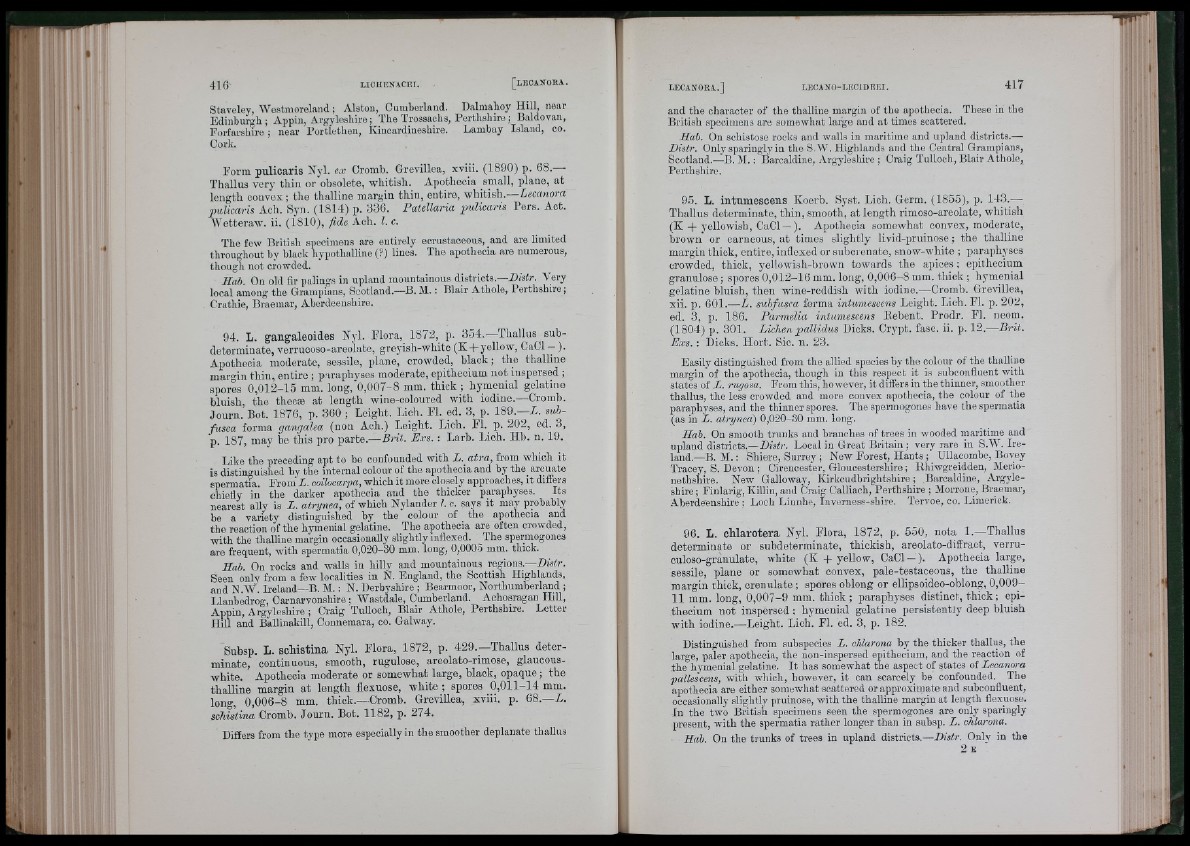
Staveley, Weatmoreland ; Alston, Cumberland. Dalmahoy Ilill, near
Edinburgh; Appin, Argyleshire; The Trossacbs, Perthshire ; Baldovan,
Forfarshire ; near Portlethen, Kincardineshire. Lambay Island, co.
Cork.
Form pulicaris Nyl. ex Cromb. Grevillea, xviii. (1890) p. 68.—
Thallus very th in or obsolete, whitish. Apotheoia small, plane, a t
length convex; th e thalline margin th in , entire, wh itish .— Lecanora
jmlicaris Aoh. Syn. (1814) p. 336. Patellaria pulicaris Pe rs. Act.
AVetteraw. ii. (1810), fide Aoh. I. c.
The few Britisli sjieciinens are entirely ecrustaceous, aud are limited
throughout by black hypotballine (?) lines. The apothecia are numerous,
though not crowded.
Hab. On old fir palings in upland mountainous districts.—Disfr. A’ery
local among the Giampians, Scotland.—B. AI. : Blair Athole, Perthshire ;
Crathie, Braemar, Aberdeenshire.
94. L. gangaleoides Nyl. Flora, 1872, p. 3 5 4 .—Tballus^ subdeterminate,
verrueoso-areolate, greyish-white (K + yollow, CaCT - ).
Apothecia moderate, sessile, plane, crowded, b la ck ; th e thalliue
margin th iu , entire ; paraphyses moderate, epitheoium no t inspersed ;
spores 0 ,0 1 2 -1 5 mm. long, 0 ,0 0 7 -8 mm. thick ; hj'menial gelatine
bluish, the thecæ a t length wine-coloured with iodine.—Cromb.
Jo u rn . Bot. 1876, p. 360 ; Leight. Lioh. F l. ed. 3, p. 189.—X. subfusca
forma gangalea (non Aoh.) Leight. Lioh. Fl.^ p. 202, od. 3,
p. 187, mav be this pro p a rte .— Brit. Exs. : Larb. Lioh. Hb. n. 19.
Like the preceding apt to be confounded with X. atra, from which it
is distinguished bv the internal colour of the apothecia and by the arcuate
spermatia. From' X. coilocarpa, which it more closely approaches, it differs
chiefly in the darker apothecia and the thicker paraphyses. Its
nearest ally is X. atrynea, of which Nylander I. c. says it may probably
be a variety distinguished by the colour of the apothecia and
the reaction of the hymenial gelatine. The apothecia are often crowded,
with the thalline margin occasionally slightly inflexed. The spermogones
are frequent, with spermatia 0,020-30 mm. long, 0,0005 mm. thick.
Hab. On rocks aud walls in hilly and mountainous regions.—Dfsfr.
Seen onlv from a few localities in N. Eugland, the Scottish Highlands,
and N.AV. Ireland—B. AI. ; N. Derbyshire ; Beamioor, Northumberland ;
Llanbedrog, Carnarvonshire ; AVastdale, Cumberland. Acbosragan Hill,
Appin, Argyleshire ; Craig Tulloch, Blair Athole, Perthshire. Letter
Hill and Ballinakill, Connemara, co. Galway.
Subsp. L. scMstina Nyl. Flora, 1872, p. 4 2 9 .—Thallus determinate,
continnous, smooth, rugulose, areolato-rimose, glaucous-
white. Apothecia moderate or somewhat large, black, opaque ; th e
thaUine margin a t length flexuose, white ; spores 0 ,0 1 1 -1 4 mm.
long, 0 ,0 0 6 -8 mm. th ick .—Cromb. Grevillea, xviii. p. 68.— X.
sehistina Cromb. Jo u rn . Bot. 1182, p. 274.
Differs from the type more especially in the smoother deplanate thallus
and the character of the thalline margin of the apothecia. These in the
British specimens are somewhat large and a t times scattered.
Hab. On schistose rocks and walls in maritime and upland districts.—
Distr. Only spariugly iu the S W. Highlands and the Central Grampians,
Scotland.—13. AI. ; Barcaldine, Argyleshire ; Oraig Tulloch, Blair Athole,
Perthshire.
95. L. intumesceHS Koerb. Syst. Lioh. Germ. (1855), p. 143.—
Thallus determinate, thin, smooth, a t length rimoso-areolate, whitish
(K + yellowish, CaCl —). Apotheoia somewhat convex, moderate,
brown or oarneous, a t times slightly livid-pruinose ; the thalline
margin thiok, entire, inflexed or siiboi enate, snow-white ; paraphyses
crowded, thick, yellow'ish-brown towards the apices ; epitheoium
granuloso ; sporos 0,012—16 mm. long, 0,006—8 mm. thick ; hymenial
gelatine bluish, th en wine-reddish with iodine.—Cromb. Grevillea,
xii. p. 601.— L. subfusca forma intumescens Leight. Lich. Fl. p. 202,
ed. 3, p. 186. Parmelia intumescens lleb en t. Prodr. F l. neom.
(1804) p. 301. Lich en p a llid u s Dicks. Crypt, fasc. ii. p. 12.—B r it.
Exs. : Dicks. H o rt. Sio. n. 23.
Easily distinguished from the allied species hy the colour of the thalline
margin of the apothecia, though in this respect it is subconfluent with
states of X. rugosa. From this, however, it differs in the thinner, smoother
thallus, the less crowded and more convex apothecia, the colour of the
paraphyses, and the thinner spores. The spermogones have the spermatia
(as in X. atrynea) 0,020-30 mm. long.
Hab. On smoolh trunks and branches of trees in wooded maritime and
upland districts.—Distr. Local in Great Britain ; very rare in S.AA’, Ireland.—
B. AI. : Shiere, Surrey ; New Forest, Hants ; Ullacombe, Bovey
Tracey, S. Devon ; Cirencester, Gloucestershire ; Rhiwgreidden, Alerionethshire.
New Galloway, Kirkcudbrightshire ; Barcaldine, Argyleshire
; Finlarig, Killin, and Craig Calliach, Perthshire ; Alorrone, Braemar,
Aberdeenshire ; Loch Linnhe, Inverness-shire. Tervoe, co. Limerick.
96. L. chlarotera Nyl. Flora, 1872, p. 550, nota 1.—Thallus
determinate or subdeterminate, thickish, areolato-diffract, verru-
culoso-granulate, white (K + y e l lo w , CaCl — ). Apothecia large,
sessile, plane or somowhat convex, pale-testaceous, the thalline
margin thick, crenulate ; spores oblong or ellipsoideo-oblong, 0 ,0 0 9 -
11 mm. long, 0 ,0 0 7 -9 mm. thiok ; paraphyses distinct, thick ; epithecium
uo t inspersed ; hymenial gelatine persistently deep bluish
w ith iodine.—Leight. Lioh. Fl. ed. 3, p. 182.
Distinguished from subspecies X. chlarona by the thicker thallus, the
large, paîer apothecia, the non-inspersed epithecium, and the reaction of
the hymemal gelatine. I t has somewhat the aspect of states of Lecanora
pallescens, with which, however, it can scarcely be confounded. The
apothecia are either somewhat scattered or approximate and subconfluent,
occasionally slightly pruinose, with the thalline margin at length flexuose.
In the two British specimens seen the spermogones are only sparingly
present, with the spermatia rather longer than in suhsp. X. chlarona.
Hah. On the trunks of trees in upland districts.—Distr. Only in the